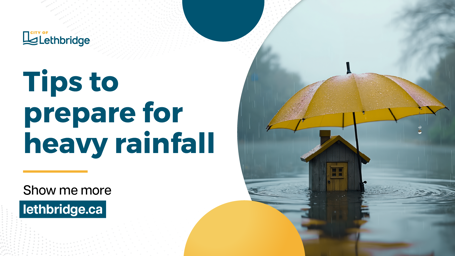Tips to prepare for heavy rainfall
Rather than sunshine, the first official weekend of summer is predicted to greet residents with heavy rainfall instead. Environment and Climate Change Canada has issued a Special Weather Statement for Lethbridge, calling for heavy precipitation amounts of between 50 mm to 100 mm, as well as and strong winds, from today to Sunday afternoon.

We have several reminders to help residents prepare for heavy rainfall events:
Prepare your eavestroughs and downspouts
Downspouts and eavestroughs protect your home from water damage by redirecting rainwater away from the foundation. They prevent flooding in your basement or crawlspace and they reduce the amount of runoff and erosion around your home. Regular maintenance of eavestroughs and downspouts is essential to keep them functioning effectively. Keep your eavestroughs are clear of leaves, twigs and other debris and pointed away from your foundation. Monitor any rain barrels with an overflow valve to ensure they are directed away from your home’s foundation.
Ensure storm drains are clear
Prior to a significant rain event, residents are encouraged to help clear storm drain blockages in front of their homes. Please call 311 when a drain is blocked during a storm and needs clearing. We will have staff on standby for urgent responses on Saturday and Sunday.
Check your sump pump
Sump pumps remove water that is collected from a building’s foundation and are commonly found in basements in Lethbridge. Here is a video link to guide you through checking your sump pump before a storm.
Check your basement
During a storm, check your basement for any leaks. See this basement flooding handbook for more information. Please call 311 if you are experiencing a sewer backup.
Parks and storm ponds
Storm ponds are designed to flood. They are built for rain events to protect the storm system and prevent basement backups/flooding. If the pond level rises significantly, it may take up to 48 hours after the rain stops for the level to return to normal – this is also normal. Excess water is released from storm ponds at a reduced rate to protect the storm infrastructure. Please keep away from all storm ponds and flooded areas during rain events, especially heavy downpours where the water levels may change rapidly. Neighbourhood storm systems are also designed to include roadway flooding if the local storm pond fills and overflows.
Roadways
If road underpasses fill with water, do not try to navigate them. Use Scenic Drive, Stafford Drive, 30 Street or 43 Street to travel north-south. Do not drive through large puddles.
Tree damage
Please call 311 to report any tree damage that creates a safety hazard or impacts public roads, alleyways or pathways.
Emergency preparedness
Learn how to prepare an emergency kit so you and your family can be self-sufficient for at least 72 hours in a scenario without power or tap water.
Additional information
- Staff at the Water Treatment Plant and the Wastewater Treatment Plant will monitor the rain event to ensure processes are maintained
- Our stormwater and wastewater information page
- Secure your garbage bins, recycling bins, green waste bins, lawn furniture, etc.
- Use caution in and near the coulees, due to potential slumping
- We are optimistic that the rainfall will help fill the Oldman Reservoir
- Please check on your neighbours!
For Public Inquiries:
Call or chat 311 | Monday to Friday, 8 a.m. to 4:30 p.m.
Contact Us
City Hall
910 4 Avenue South
Lethbridge, AB T1J 0P6
Phone: 311
or 403-320-3111 (if outside of Lethbridge)
